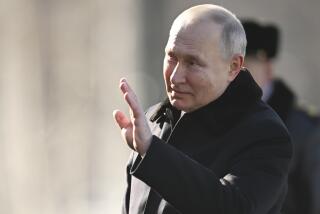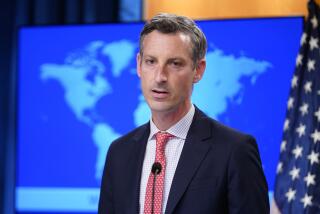Pentagon Agency to Check Treaty Compliance
- Share via
WASHINGTON — The Pentagon is establishing a new Defense Inspection Agency as the primary office to assure compliance with the recently signed intermediate nuclear forces treaty with the Soviet Union, Secretary of Defense Frank C. Carlucci said Monday.
The agency will spend between $180 million and $200 million this fiscal year to begin the task of carrying out the extensive verification provisions, Carlucci told the Senate Armed Services Committee during a ratification hearing on the treaty.
The agency also will be responsible for destroying U.S. medium-range nuclear missiles, which were banned under the treaty signed by President Reagan and Soviet leader Mikhail S. Gorbachev in Washington on Dec. 8.
Sources said that the office will be headed by Brig. Gen. Roland Lajoie, former chief of the U.S. Military Liaison Mission. The mission, based in East Germany, monitors Soviet military exercises. Lajoie, who served two tours as military aide at the U.S. Embassy in Moscow, is currently defense attache at the American Embassy in Paris.
Placement of the new agency at the Pentagon is a victory of sorts for the Defense Department over the State Department, which argued that the office should be part of State’s Arms Control and Disarmament Agency. With the new office’s prestige, however, the Pentagon also gets its considerable bills.
Its costs are expected to rise over the next several years as the United States invests millions in sophisticated monitoring gear at the Votkinsk Machine Building Plant in the western Soviet Union, where the Soviets built SS-20 missiles, their medium-range missiles banned by the treaty. The United States also will be spending heavily to support the monitoring bureaucracy and to upgrade spy satellites and other electronic intelligence-gathering equipment.
At the Pentagon, the office will report to the senior executive group for policy, consisting of Air Force Gen. Robert T. Herres, vice chairman of the Joint Chiefs of Staff; Robert B. Costello, under secretary of defense for acquisition, and Ronald F. Lehman, assistant secretary of defense for international security policy.
The new agency will employ about 400 people, divided into “red” and “blue” teams. The former will travel to the Soviet Union to inspect Soviet military facilities for violations of the treaty. The blue teams will escort Soviet inspectors when they come to the United States.
Under terms of the treaty, the United States and the Soviet Union each will station inspectors permanently at one missile plant on the other’s territory, the United States at Votkinsk, the Soviets at the Hercules Plant at Magna, Utah, where the now-banned Pershing 2 missiles were produced.
In addition, the two sides will be allowed “challenge” inspections of certain military facilities on the other country’s soil for the 13-year treaty verification period. The treaty calls for 20 such short-notice inspections during each of the treaty’s first three years, 15 a year for each of the next five years and 10 for the final five years.
The Defense Inspection Agency’s inspectors, in addition to monitoring Soviet facilities to ensure that the missiles are being eliminated, will be responsible for collection of military and industrial intelligence during inspections.
Its personnel escorting Soviets to American military installations will have some counterintelligence duties, to assure that the Soviets are not engaged in any spying in the guise of treaty inspection, Pentagon sources said.
Each U.S. inspection team will have at least one Russian-speaking member, according to military officials. The composition of the team beyond that remains unsettled, although the State Department is insisting on sending at least one diplomat with each team.
The State Department and the Pentagon are debating how many technical experts or intelligence specialists, civilians or military officers, should staff each team.
Lajoie was involved in two incidents that made headlines when he was at the Military Liaison Mission in East Germany. In March, 1985, a U.S. officer serving under him, Maj. Arthur D. Nicholson Jr., was shot and killed by a Soviet soldier. Moscow charged that Nicholson had been in a restricted zone spying on a Soviet military facility.
Four months later, then-Col. Lajoie was injured in a crash in East Germany. He was observing a Soviet military unit when his truck was struck by a 5 1/2-ton Soviet truck. The United States originally protested the deliberate “ramming” of Lajoie’s vehicle but later said that the incident may have been an accident.
More to Read
Sign up for Essential California
The most important California stories and recommendations in your inbox every morning.
You may occasionally receive promotional content from the Los Angeles Times.











